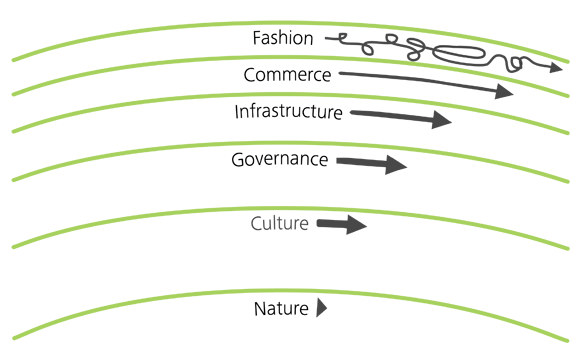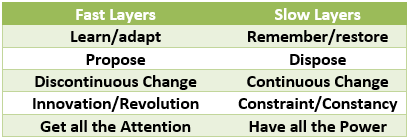Thinking Fast and Slow
I’ve been doing a lot of research lately on the future of real estate. This is an easy and popular topic – so much of it is tangible and visually interesting.
One thing really stands out. We’ve had some radical shifts in how we think, act, and organize. Yet, our physical world has been relatively unchanged for decades. We have the same streets, the same buildings, and the same forms of transportation. Cities change slowly. Parts grow, parts fade away. Yet the “bones” often remain across the generations.
Understanding why change doesn’t happen is almost as interesting was why it does. One of my favorite explanations comes from Stewart Brand, of the Long Now Foundation. He writes about this in his book How Buildings Learn.
Brand noticed that while collective change is now a given, not everything adjusts at the same rate.

This is a layered view of the world that we live in. Brand refers to this as "pace layer thinking."
- Fashion and technology move very quickly. Every few months, there are trendy new lines of clothing, movies to watch, and music to follow. Our language is surprisingly adaptable.
- Commerce and businessdo their best to keep up with the times, rolling out new offerings and updating existing ones. The start-up period between idea and reality is quickening, but it can still take years to introduce an entirely new product.
- Infrastructure projects take significant planning, and often require a decade or more to build out. Part of this relates to the red-tape involved in obtaining approvals, and the need to raise massive amounts of capital.
- At the layer of governance, building codes and zoning regulations can last a century or more.
- Culture is not so much about fashion as it is about core values and traditions. The time frame for change can be hundreds (if not thousands) of years.
- And in the end, nature has the final word. It will last longer than civilization.
Between each of these layers, you’ll have an element of turbulence and friction. This is where public discussion frequently happens. The faster moving layers get all the attention, while the slower moving layers have the power.

Pace layer thinking explains why cities and our built environment tend to change slowly over time. It provides insights to why the market for hydrogen fuel is so small (infrastructure), or why crypto-currencies might not hit ever reach the mainstream (governance). Cultural considerations are also significant. We may have some of the technology needed for genetic engineering, yet are reluctant to embrace it.
So, next time you encounter a new investment concept, take some time to consider why it might work out (or not). Think fast. Think slow.
Jim Lee CFA, CMT, CFP®
Founder, StratFI.
Disclosure: Information contained herein is for educational purposes only and is not to be considered a recommendation to buy or sell any security or investment advice. Securities listed herein are for illustrative purposes only and are not to be considered a recommendation.
